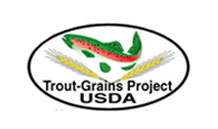
USDA - ARS
Trout-Grains Project
Ingredient Enhancement Program
Some feed ingredients are readily available but have a nutritional profile that is not optimal for aquatic feeds. For example, fiber or ash levels may be too high, or protein levels may be too low. A processing method that modifies the nutritional profile of ingredient dramatically increases its value. In another situation, ingredients maybe nutritionally complete but are too costly. For example, a food grade soy protein concentrate is a very nutritious and effective feed ingredient in aquafeeds, but it is too expensive to be used at significant levels in many types of aquafeeds. When either case arises, modification can be used to increase both the nutritional and economic value of the ingredient.
ARS, Trout-Grains Project, has an active program for ingredient modification and development. This program is conducted both in-house, and in collaboration with ingredient suppliers or ingredient buyers. As these ingredients are improved they are evaluated through a series of fish feeding trial in another section of the Project.
In general, ingredient modification and development consist of two major strategies. The first strategy is to further process or fractionate an existing ingredient for nutritional enhancement by concentrating desirable nutrients and/or reducing undesirable nutrients. Three methods have been explored for this strategy, involving Mechanical, Chemical and Biological approaches. The mechanical approach is also sometimes called dry fractionation. It may include dehulling, pearling, milling, sieving, air classification and a combination. This method uses no solvents so no drying is required and is the least expensive approach. However, it has limited effect on nutrient concentration or anti-nutrient reduction. The so-called Chemical approach is also known as wet fractionation which uses at least one solvent to extract nutrients from existing raw material followed by drying. This does not always include true chemical reactions but wet processes are usually referred to as a chemical approach. Maximum extraction efficiency is achieved by using different solvents with varying concentrations, extraction durations, and temperatures. It is an effective way to concentrate or reduce a nutrient, but the cost associated with it is much higher than dry fractionation. The Biological approach involves active fermentation with yeast, bacteria or fungi to concentrate or reduce a compound from an ingredient. There are several new ingredients on the market using this approach and improvements in production efficiency may decrease the cost of these products in the future.
The second strategy for ingredient modification and development is to start at the stage of ingredient production. Most feed ingredients are co-products during processing of oilseed, grain or other plant material for food or fuel. By using a modified or new processing method, existing co-products can be improved in both quality and production efficiency or a new co-product can be produced. For example, in dry grind processing of corn into fuel ethanol, modification of certain process steps, such as adding a feedstock pretreatment, has been shown to improve the nutritional profile of a major co-product, distillers dried grains with solubles (DDGS). This second strategy also includes selecting right raw material for ingredient production. For example, low-phytate barely or other crops are being bred. When utilized as a feedstock for ethanol production, the low phytate crop could lead to production of low-phytate DDGS.
